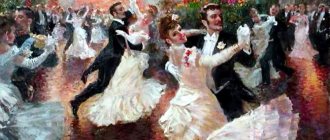The origin of the waltz is still debated, but it was popularized in Austria in the 18th century, and then spread to other countries. Its name comes from the German word "walzen", which means "to whirl".
This dance was not immediately accepted by the upper class of society and was even considered indecent due to the close contact of dance partners. However, now the waltz is known, loved and danced in many countries around the world. Today we will talk about how to dance the waltz.
A distinctive feature of this dance is that it should be danced in three-quarter time, that is, there are three steps for each measure. Try counting out loud: “one, two, three”, “one, two, three”, with amplification of “one” - this is one beat.
Types of waltz
The waltz is a traditional decoration for weddings, balls and proms. This dance immerses people in a special atmosphere and attracts generations of different ages. The waltz has several versions of its origin. Waltz dance appeared at the end of the 18th century in Vienna and quickly gained popularity in secular society. Increased interest in this form arose due to Queen Victoria's passion for ballroom dancing. For European countries and the whole world, the waltz became the basis for the emergence of many other dance styles.
Waltz has many varieties. Several main types are popular:
- A very graceful dance with quickly moving foot positions is called the Viennese Waltz . The main requirements for this variety are a toned body and restraint when making bends. The technique of this dance involves a constant alternation of right and left turns. The dancers' movement speed is above average.
Viennese
- The dance, combining the basic elements of the classical waltz and tango, is called the Argentine waltz. The basis is taken from tango elements. This technique has its own unique score. The Argentine waltz is the most dynamic among other varieties. The dance is quite fast and includes complex elements.
- The most popular type of slow dance is called English waltz . Despite the fact that this trend originated in several countries, its final formation took place in England. This species has another, more popular name - Boston Waltz . The technique of this dance is filled with smooth soft movements. The partners' movements are wavy and sliding. The English waltz is filled with romance. Simple, at first glance, movements require high skill from dancers.
History and development
The waltz first appeared in the 70s of the 18th century, but for the next hundred years it was banned at balls and receptions. Prim aristocrats and church ministers condemned this dance. After all, holding your lady by the waist in front of everyone was indecent.
The waltz originated among the common people. But it is impossible to name one country where this dance was performed. It traces the motives of several nations at once:
- Austrian Landler;
- Czech furiant;
- French volta.
Ländler was first part of the matchmaking ritual. The young man circled the girl he liked around him. This is how he showed the seriousness of his intentions. Furiant is a real theatrical performance. The proud young man grabbed his pretty partner by the waist, pulled her towards him and danced with her. And volta is constant turns and circling of pairs.
Most of all, the modern waltz is similar to the landler. From rural holidays, it came to the homes of aristocrats thanks to Maria Theresa, Archduchess of Austria. The girl liked the dance so much that she moved it to the hall of her palace.
How to learn to dance the waltz?
Waltz is a romantic dance for couples. The ability to dance the waltz has become a sign of good manners. Partners have the opportunity to express their respect for each other or become even closer.
- In order to fully master this dance and show your skills, it is advisable to start practicing in childhood. Children have well-developed memory and analytical abilities. Flexibility of the body makes it easier to absorb loads and adapt to new movements. These factors provide faster results.
- Therefore, if your child shows a desire, then do not delay in enrolling in a ballroom dancing club. In just two or three years you will be able to be proud of the performances of your growing dancer. Ballroom dancing lessons develop discipline in children and provide aesthetic and musical pleasure. Dance achievements will begin to grow, and, if desired, can develop into success.
- If the desire to learn to dance the waltz has arisen in an adult, then the first thing you need to stock up on is patience. During the learning process, it is important not to shirk on training and to be persistent. Of course, not everything will work out right away. But if you wish, the process will definitely go on track. High-quality classes will help you master a beautiful dance to perfection.
Dance the waltz
- The easiest way to learn dance is to attend courses. A qualified trainer will quickly find an approach to you, help you open up and quickly teach you the basic movements.
- You shouldn't take the first course you come across. Take time to visit several places and choose the one that is most comfortable for you. Listen to the feedback of friends and acquaintances. If the place is good, it is most likely popular. The best option for making a suitable choice is to attend the first free lesson. This will be enough to get to know the teacher, the composition of the group, and the schedule.
Waltz
For various reasons, a small category of people prefer to study with a private teacher. This type of training will require larger financial investments than group classes. But individual lessons help you put aside inhibitions and quickly achieve the best results.
Having a busy work schedule and a lack of free time, choose the option of teaching dance at home.
Video for the dance element “Waltz turns in 3 positions”
The dance element is demonstrated by:
- KONDRATENKO Galina Mikhailovna is the head of the City Methodological Association of Ballroom Dance Teachers at the St. Petersburg City Palace of Youth Creativity. The recording was made at the seminars of the City Methodological Association of Ballroom Dance Teachers of St. Petersburg;
- KOROTKOVA Natalya Feliksovna is the leader of the ballroom dance group “On Poklonnaya”. The recording was made at the dance Seminars and workshops of the UNESCO International Dance Council in St. Petersburg, 2014-2015 academic year.
- The waltz in pairs is performed by members of the ballroom dance group “On Poklonnaya”, director N.F. Korotkova.
How to effectively learn to dance the waltz at home?
Before you start learning, you need to set your priorities. What is important to you – learn to dance professionally or twirl in a beautiful outfit at a theme evening. If your skill is more important to you, then you should find a private teacher.
- First of all, personal training will allow you to effectively plan your free time. A personal teacher will give an objective assessment of your prospects and help you achieve your goal. In order to go as deep as possible into the dance process, take the time to familiarize yourself with information about the types of waltz, their history and features.
- In order to learn any type of dance, you need to learn to feel the rhythm of the music. One option is to do household chores while listening to waltz tunes. Listen to the musical transitions. Try dancing in your mind to the music playing.
- Whenever possible, hone your skills with training videos. The privacy of your home will help you concentrate on the process. The video allows you to return to problematic moments and repeat the desired movements. This way, you will be able to tighten up the complex elements of the lesson, having your own time and without making additional financial investments. If you can’t find suitable lessons, you can purchase already prepared training material on disk.
Waltz
- If among your friends there are experienced dancers, then do not miss the opportunity to work out with such a person. This will allow you to correct your mistakes and receive valuable comments. It is best to combine a set of activities. Work out at home, with a trainer, attend open classes and special events. Try dancing with new partners.
Love what you do. Surround yourself with romance and beautiful dance attributes. Make learning to dance your hobby. Then you are guaranteed to achieve a successful result.
Preparation stages
After the main parameters that determine the nature of the wedding dance (see above) have been determined, the newlyweds need to :
- choose a time and place for training . It is desirable that the conditions of the site approximately correspond to the future dance floor. For normal preparation, at least three to five half-hour rehearsals will be required for dancers of average training, 5-8 rehearsals for poorly trained people;
- choose a dance pattern and break it into separate elements . The same goes for musical accompaniment. Each fragment-link is learned separately, then they are combined into a single whole;
- conduct at least one rehearsal in clothes as close as possible to wedding clothes . You should take into account the height of the heel, the length and width of the bride’s skirt, and the comfort of the groom’s suit.
The last rehearsal is an excellent opportunity for the bride to break in her wedding shoes or finally make sure that they need to be replaced with a more comfortable model.
Features of the correct waltz technique
Before honing your waltz technique, you need to pay attention to physical preparation. Your body needs sports training. You may not want to do it at all, but preparing your body is a must to perform the correct movements. It is advisable to perform such exercises to the music of a waltz.
- Your movements should be smooth and harmonious with the music. Avoid sudden movements. This will avoid injury due to inexperience. The hands and toes especially need stretching. To develop them, use rotations and lifts.
- Make sure your fingers are tight and your hands are at shoulder level. When dancing a waltz, you should not raise your shoulders. This situation immediately catches the eye and spoils the visual perception.
- Training with a partner gives more effective results. If desired, learning to waltz will help bring you closer to your partner. For a married couple, waltzing will help strengthen their relationship.
The most important movement in a waltz is whirling. The right turn is of paramount importance. A full, complete turn can be divided into two half-turns of 180 degrees.
Gentle waltz
Let's take a closer look at the movements performed:
- The first step is taken with the right foot in a left-to-right direction.
- Next, step with your left foot in the direction of the turn.
- The combination of the right and left legs occurs on the half toes.
- Next, the closed legs are lowered to full feet.
- The second half-turn involves steps back with the left foot.
- The first step back is taken diagonally, the second step to the left.
- The main load during the second half-turn falls on the left leg.
- The right leg passes behind the left heel and then rotates on the half toes.
The classical waltz consists of three main positions. A professional dancer needs to learn how to master each of them. Let's consider the main nuances of these positions.
Dancing
- Closed pair position. Partners line up opposite each other. The partner is slightly shifted to the right of the leader. The partner's left hand clasps the partner's body and is located on the left waist. The follower holds her left hand just below her partner's right shoulder. The dancers' other two hands are combined on bent elbows at right angles. The legs are placed in the sixth position. Correct vertical posture will help you maintain balance while dancing.
- Promenade pair position. This position is based on a closed position with a slight characteristic difference. On one side, the partners' bodies are turned away from each other. On the other side, the shells touch, thus creating a visual mark. The partner has a head tilt to the left, the woman has a head tilt to the right.
- Basic pivot, lock and brush. In a slow waltz, the pivot turn is performed on the toe of the right foot. The other leg is extended forward or backward. The lock position refers to the position of the feet in which one leg is placed crosswise in front or behind the other. The brush maneuver involves the free movement of the paired leg towards the supporting leg with a further choice of the direction of movement.
Learning the movements
The basis for learning the waltz is only two movements. Once you master them, you can move on. So, let's learn the turn. When a couple dances a waltz, the movement is performed 360 degrees. First learn this waltz movement on your own, and then in pairs.
Let's learn the first half of the movement:
- It is necessary to count: one-two-three, repeating the count three times to the music.
- Face the line of dance.
- The legs should be in position No. 3.
- Take one step forward, starting with your right foot (count - one).
- Then take a step with your left foot and turn to the right (count - two).
- When turning, you will stand with your back in the line of dance.
- Gently pull your right leg towards your left leg. Get into position No. 3 (count - three).
- Consolidate the movement. Do it several times.
- Remember that you are learning half a turn, and therefore turning 180 degrees.
- Perform the movement on half toes, and when completing it, stand on your entire foot.
- When finishing the movement, do a light squat.
- Your movements should be sliding.
Learning the second half of the turn:
- We stand with our backs to the dance line.
- Legs in position No. 3.
- With the left foot, step to the side (count – one).
- Don't turn around yet.
- Place your right leg inverted (count – two).
- Gently turn on your toes to the right.
- The count is three and you find yourself facing the dance line.
- You have turned your body 180 degrees.
- Perform the movements several times.
- Take the first step diagonally, first back and then to the side. The leg should be turned out.
- When moving the second step, place your left heel close to your right foot.
- You should be in leg position #3.
- Keep your body weight on your left leg.
Making a full turn:
- Face the line of dance.
- Legs in position No. 3.
- Perform the first half of the turn with your back to the line of dance.
- Turn right and begin the second half of the movement.
- You must return to your starting position.
- Practice, perform the movement several times.
- After your body and legs get used to the movements, turn slowly at first, then faster and faster.
Now you have already learned how to make a turn on your own. But this is only a small part of your success. Ahead is learning how to turn in pairs. The girl starts moving with her right foot (facing the dance line), the boy starts with the left foot (with his back to the dance line). The girl dances the first half of the turn, the boy the second. That is, in a pair, partners simultaneously perform a turn, only different halves.
Advice for couples:
- Don't try to make a quick turn right away.
- Watch your feet.
- In dancing you need to move forward along the line of dance.
- Don't focus on performing two parts of the turn; the movements should be smooth.
Practical recommendations for mastering the waltz technique
When dancing a waltz, partners move in space along the lines of a square. There is a term for the main step in the waltz - left square. The stop between steps occurs at the corners of the square. The direction of movement is along the edges and diagonally in a square shape. A visual representation of your dance pattern will help you get your bearings faster. Throughout the waltz, the dancing couple outlines several squares.
The rhythm of the waltz is maintained using a triple count. When taking steps, partners constantly say one, two, three. The width of your steps is approximately equal to the width of your shoulders.
Turns are inserted between the main steps of the waltz. Such elements give the couple elegance. Turns should only be attempted after the basic steps have been well rehearsed. Beautiful turns and tilts help to adhere to the correct technique and relieve tension in the dance.
After solo training, you need to start training with a partner. A big advantage in learning is the ability to dance in a circle with several couples. A large number of partners allows you to learn to adapt to new maneuvers and navigate in space. In a pair dance there is a division into a leader and a follower. As a rule, the role of leader in a waltz is performed by a man.
Bright Waltz
Based on this, let's look at several requirements that are necessary for a proper rack:
- The leader's right hand is placed on the partner's upper left shoulder blade. The right elbow is placed at the level of her shoulder.
- The trailing partner places her left hand on the leading partner’s forearm.
- Elbows are always placed at shoulder level and never drop.
- The back and neck are always straight.
- The partners look at each other without lowering their chins.
Modern waltz dance has many varieties. Each of them has its own characteristics. But all types of waltz are united by one common classical rhythm - one, two, three.
Learning to waltz will tone your body and give you confidence. An active lifestyle will have a positive effect on your health. Start dancing the waltz and peace of mind is guaranteed.
Final dance
At the end of the wedding reception, the newlyweds usually perform a final dance. Thus reminding guests that the newlyweds are the main heroes of the occasion. The touching last dance of the newlyweds will put a beautiful ellipsis before the beginning of their life together.
The dance at the end of the wedding evening may be the same one that was performed at the beginning of the holiday. The newlyweds dance for an encore and are the first to leave the wedding banquet. At its completion, additional special effects can be used: smoke, light, confetti or fireworks, Chinese lanterns.
By the end of the wedding, after an exciting day, the newlyweds usually feel tired. Therefore, it is better to perform a romantic final dance to calm, melodic music.
The first dance of the spouses is elegant, sensual and tender, it will remain in memory for many, many years. It will be nice to get a disc with the recording on your next wedding anniversary and enjoy the magical dance again. Or maybe perform it again.
Staging the first wedding dance
The first wedding dance of the newlyweds should be special so that it is remembered as a pleasant and sincere moment of the festive evening
That is why its organization should pay special attention and, above all, the choice of dance style
Waltz
The classic wedding dance for newlyweds is the waltz, which even couples who have a limited amount of time can prepare. Newlyweds only need to learn a few steps to achieve a smooth and beautiful dance. The waltz is suitable for romantic and sensual people who dream of remembering the dance as a touching action.
https://youtube.com/watch?v=iYTbpmxyX8c
Tango
Spectacular and ardent newlyweds can express their passion through hot tango, which is one of the most beautiful types of wedding dance
In its production, it is important to pay attention to technical aspects, which may seem quite complicated to beginners. This dance of the newlyweds at a wedding will look beautiful if all movements are precise and synchronous.
Rumba
A sensual and emotional rumba is perfect for the first wedding dance, but staging it will require quite a lot of time and effort. It is best to start preparing a few months before the celebration so that your dance looks stylish and impressive. To choreograph a wedding dance, schedule at least 20 rehearsals into your schedule with a choreographer who can help even beginners achieve coordinated movements. At home, you can also practice your rumba while enjoying each other's company.
Salsa
Dance mix
For newlyweds who already have some dance experience, it is possible to stage a combined dance consisting of several different styles. Changing the music and rhythm will make your dance a real show. To create even more impact, you can order a light show or wedding fireworks that will decorate the dance.
Choreographer
For those who want to show guests a complex dance composition, it is better to turn to professionals for help. The choreographer will not only choreograph the dance, but will also work out all the movements with the couple. Angela Larionova
Waltz King
Times are changing, but the waltz as the first dance of newlyweds has not yet lost its position. In combination with music and the tender feelings of the newlyweds, such a dance will definitely decorate a wedding celebration:
If the couple has chosen a classic wedding style, then the waltz will fit perfectly into the concept of the celebration. What else can you wear to perform this dance, if not in a long, fluffy ball gown? This is exactly what many brides choose.
Not everyone can easily and gracefully twirl to a beautiful melody, for example, the Viennese waltz. Still, completely different rhythms and movements are in fashion today.
But any couple can learn basic waltzing movements. You can choose a figured waltz, it is easier to perform.
Foxtrot – harmony of feelings
Don't let the name scare the newlyweds.
Yes, you won’t be able to dance it without preparation. If the couple chose the foxtrot, then they will have to turn to a choreographer for help and rehearse intensively. But many melodies, both ancient and modern, are suitable as accompaniment. They should be slow but rhythmic; the couple will be able to move gracefully to such music.
The elements of this dance are smooth and gliding; to perform it you need a spacious dance floor.
Tango of love
Another option is tango. It suits a more emotional couple who also has dancing skills. If the dance is performed at the proper level, it will become a highlight of the wedding program.
But you shouldn’t focus on the desire to amaze your guests. The first dance is not so much for them as for the couple themselves. So, you should think carefully before choosing such a complex and passionate dance.
Moreover, the bride’s outfit must match it. Performing tango in a dress with a fluffy long hem is uncomfortable and inappropriate.
Sensual bachata
The birthplace of bachata is the Dominican Republic, this dance is very sensual. The main thing is to move plastically, in close contact with your partner. There are few dance movements, the emphasis is on intimacy with each other. Bachata is the choice of a rather extravagant couple. The groom gently but confidently leads the bride, and she should move like a cat, gracefully and easily. 4/4 is the musical time signature of bachata.
Latin Expression
Temperamental couples choose dances in the Latin American style - samba, rumba, cha-cha-cha, salsa, paso doble. Such a performance by young people will be very incendiary. But you will have to rehearse thoroughly, because without preparation it is unlikely that you will be able to perform these expressive compositions.
The bride's outfit should match the dance - since the emphasis in the movements is on the hips, the skirt should be shortened and tight-fitting.
Mixed style
A popular dance of newlyweds today can be called a mixed, combined composition. In this case, preparation is required especially carefully. For example, the beginning can be slow, classical, and in the middle any improvisations are possible - in Latin American style, rock and roll, disco, hip-hop, flamenco, R'N'B.
But all these dance surprises should, first of all, please the newlyweds themselves and correspond to their character and temperament.











